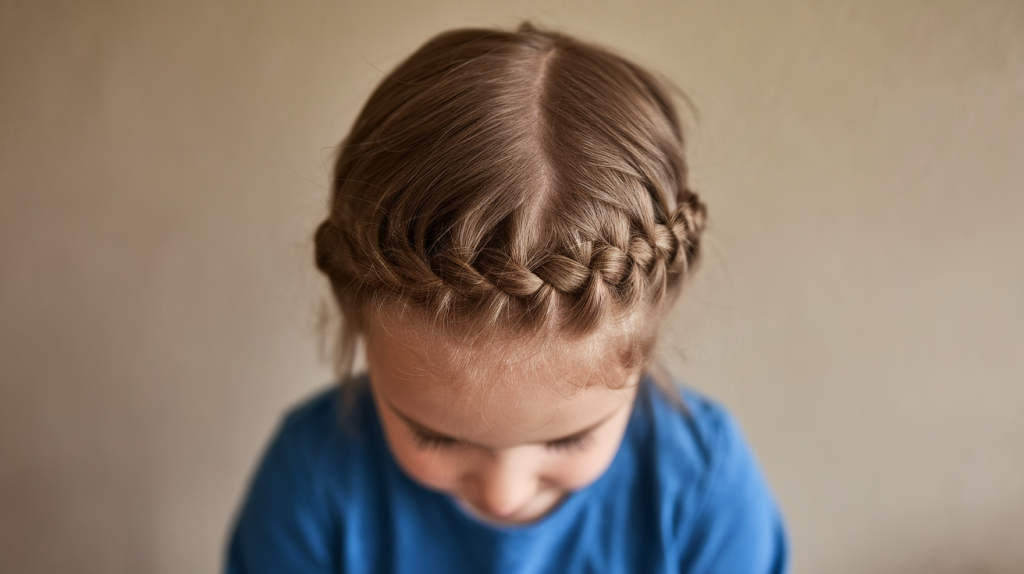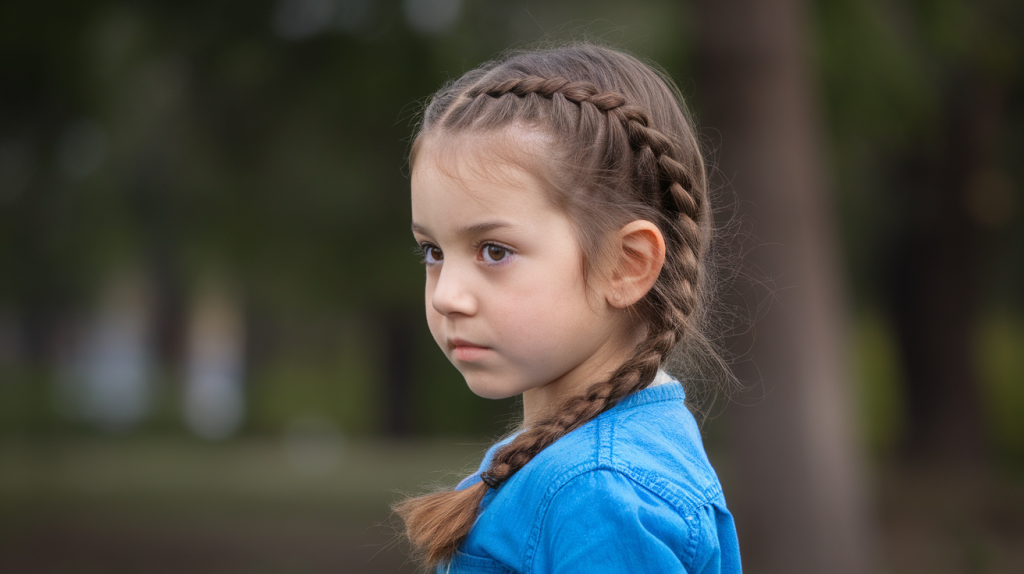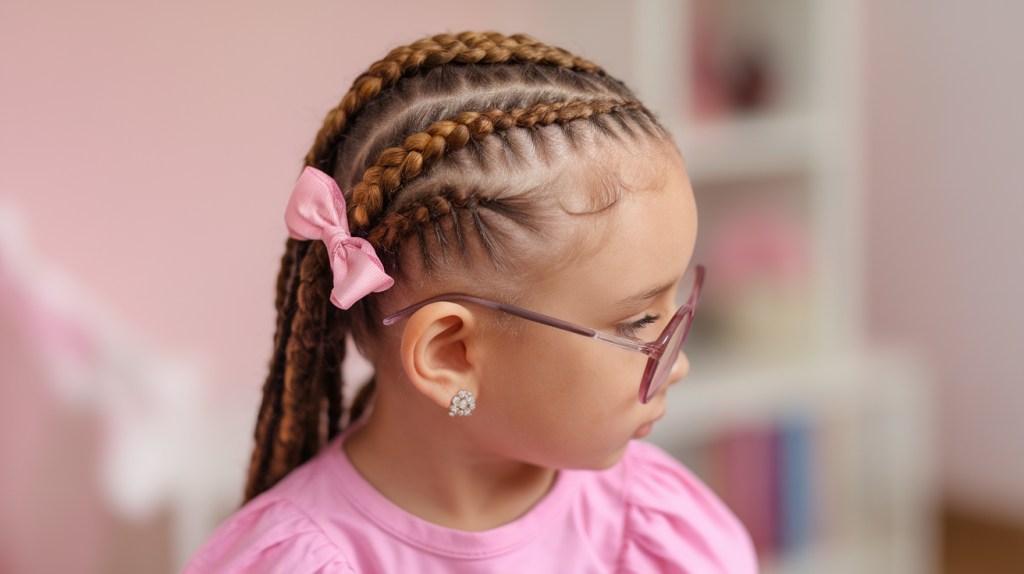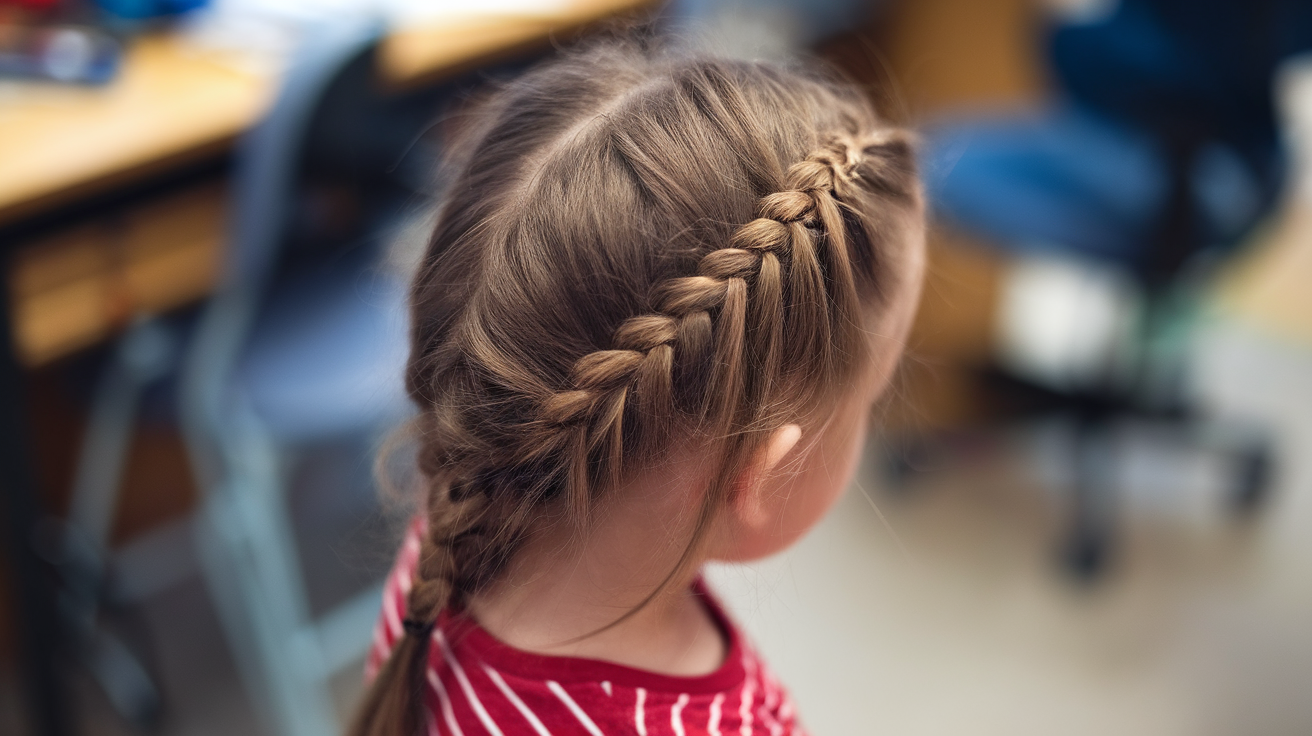French braids are a classic hairstyle that has stood the test of time. This elegant and practical hairdo involves weaving three sections of hair together, gradually adding small pieces from the sides as you braid down the head. The result is a beautiful, intricate pattern that lies close to the scalp and cascades down the back.
For kids, French braids offer a perfect blend of style and functionality. They keep hair neat and tidy, which is especially helpful for active little ones who love to play and run around. Parents appreciate how this hairstyle can last for days, reducing the need for daily styling. Plus, French braids work well for various hair types and lengths, making them a versatile choice for children.
The benefits of French braids for children’s hair go beyond just looks. They help prevent tangles and knots, which can be a real hassle for both kids and parents. This protective style also minimizes hair breakage and can even promote hair growth by keeping the ends tucked away. In the following sections, we’ll share easy techniques for creating French braids, explore cute variations, and offer tips on how to accessorize these lovely hairstyles for your little ones.
- What makes French braids ideal for children?
- How to French braid your child's hair
- What are some cute French braid variations for kids?
- How can you accessorize French braids for little ones?
- What are common challenges when French braiding kids' hair?
- Braiding Bliss: Crafting Memories and Styles
- Frequently Asked Questions
What makes French braids ideal for children?

French braids are a fantastic hairstyle choice for children. They offer a perfect blend of practicality and style that parents and kids alike can appreciate. Let’s explore why this classic hairdo is so well-suited for little ones.
Keeps hair neat and tidy
One of the biggest challenges parents face is keeping their child’s hair looking presentable throughout the day. French braids excel in this area. By weaving the hair close to the scalp, they create a smooth, polished look that stays in place even during active play.
Have you ever noticed how quickly a child’s hair can become messy? With French braids, you can say goodbye to constant hair fixes. The tight weave helps to control flyaways and keeps stray hairs from falling into your child’s face. This means less distraction during school or playtime, and fewer complaints about hair getting in the way.
Reduces tangles and knots
If you’ve ever had to brush out a child’s tangled hair, you know how frustrating it can be for both parent and child. French braids offer a solution to this common problem. By keeping the hair securely woven, they minimize the opportunity for strands to tangle or knot.
This protective style is especially beneficial for children with fine or curly hair, which is more prone to tangling. With French braids, you can reduce the time spent on detangling sessions, making hair care routines quicker and less stressful for everyone involved.
Suitable for various hair lengths
One of the great things about French braids is their versatility when it comes to hair length. Whether your child has short, medium, or long hair, this style can work wonders. For shorter hair, mini French braids or a half-up style can be created. Longer hair allows for full-length braids or even more intricate styles.
This adaptability means that French braids can grow with your child. As their hair gets longer, you can experiment with different variations of the style, keeping things fresh and exciting.
Versatile style options
Speaking of variations, French braids offer a wide range of styling possibilities. This versatility is perfect for children who like to change up their look or for parents who want to match the hairstyle to different occasions. Here are some popular French braid variations:
- Single French braid down the back
- Double French braids (pigtail style)
- French braid crown
- Side French braid
- French braid into a ponytail or bun
These options allow you to create a new look each time, keeping the hairstyle interesting for your child while maintaining its practical benefits.
Long-lasting hairstyle
Perhaps one of the most appealing aspects of French braids for busy parents is their longevity. Unlike many other hairstyles that need to be redone daily, French braids can last for several days with proper care. This durability is a huge time-saver for morning routines.
To help the style last longer, consider braiding slightly damp hair and securing the ends with a strong elastic. At night, a silk or satin pillowcase can help reduce friction and keep the braid intact. With these tips, you might find that your child’s French braid can look great for up to a week, depending on their hair type and activities.
French braids are more than just a pretty hairstyle. They offer practical solutions to common hair care challenges that parents face with their children. From keeping hair neat and tangle-free to providing versatile styling options, this timeless look has much to offer. Plus, the long-lasting nature of the style means less daily styling time, which is a win for both parents and kids.
Next time you’re looking for a hairstyle that combines function and fashion for your little one, consider giving French braids a try. You might be surprised at how this classic style can simplify your hair care routine while keeping your child looking adorable.
How to French braid your child’s hair

Creating a French braid in your child’s hair might seem challenging at first, but with practice, it becomes easier. This classic hairstyle can be a fun bonding experience for you and your little one. Let’s break down the process into manageable steps.
Preparing the hair
Before you start braiding, it’s crucial to prepare your child’s hair properly. Begin by detangling the hair gently using a wide-toothed comb or a brush designed for your child’s hair type. If the hair is very tangled, you might want to use a detangling spray to make the process smoother and less painful for your child.
Should you braid wet or dry hair? While it’s possible to braid both, slightly damp hair often provides better grip and can result in a neater braid. You can mist the hair lightly with water or use a leave-in conditioner for added moisture and manageability.
Sectioning techniques
Proper sectioning is key to creating a neat French braid. Start by parting the hair down the middle from the forehead to the nape of the neck. This creates two equal sections if you’re planning to make two braids. For a single braid, you don’t need to part the hair.
Next, at the crown of the head, separate a small triangle of hair. This will be your starting section for the braid. The size of this section can vary depending on how tight you want the braid to be – a smaller section typically results in a tighter braid.
Step-by-step braiding process
Now comes the fun part – the actual braiding! Here’s a simple guide to follow:
- Divide your starting section into three equal parts.
- Cross the right strand over the middle strand.
- Then cross the left strand over the new middle strand.
- As you continue this pattern, start incorporating small sections of loose hair from along the hairline into each strand before you cross it over.
- Keep the braid close to the scalp as you work your way down.
- Continue this process, adding hair to each section before crossing it over, until you reach the nape of the neck.
Remember to keep your movements smooth and consistent. It might take some practice to get the hang of adding hair while braiding, but don’t get discouraged. With time, your fingers will develop muscle memory, making the process quicker and easier.
Securing the braid
Once you’ve braided all the hair, continue the regular three-strand braid pattern down the length of the hair. When you reach the end, secure the braid with an elastic band that matches your child’s hair color. For added security, especially for active children, you might want to use a second elastic band about an inch above the first one.
If your child has layers or shorter pieces of hair that don’t reach the braid, you can secure these with small bobby pins that match their hair color. Slide the pins in with the open end pointing towards the scalp for the most secure hold.
Tips for a neat finish
Want to give your child’s French braid that extra polished look? Here are some pro tips to elevate your braiding game:
- Use a fine-toothed comb to smooth each section before incorporating it into the braid
- Apply a small amount of hair gel or mousse to tame flyaways
- Gently pull on the edges of the braid to loosen it slightly, giving it a fuller appearance
- Spray a light mist of hairspray on a soft-bristled toothbrush and use it to smooth down any baby hairs around the hairline
Creating a French braid takes patience and practice. Don’t worry if your first attempts aren’t perfect – even professional hairstylists had to start somewhere! The key is to keep trying and to make it a fun experience for both you and your child.
As you become more comfortable with the basic French braid, you can start experimenting with different variations. Try a side braid, double French braids, or even a French braid crown. Each new style will help you improve your technique and give your child exciting new looks to show off.
Remember, the most important thing is not perfection, but the time spent bonding with your child. So grab your comb, put on some fun music, and start braiding!
What are some cute French braid variations for kids?

French braids offer a world of possibilities for styling your child’s hair. With a few tweaks and variations, you can create a variety of adorable looks that are both practical and stylish. Let’s explore some cute French braid variations that will make your little one stand out.
Single French braid
The classic single French braid is a timeless choice that works well for various occasions. This style starts at the crown of the head and continues down to the nape of the neck, incorporating all the hair into one neat plait. It’s an excellent option for school days or active play, as it keeps hair securely in place.
To add a fun twist to the single braid, try incorporating colorful ribbons or small flowers as you braid. This simple addition can transform the look from everyday to special occasion-ready in no time.
Double French braids
Double French braids, also known as French pigtails, are a playful variation that’s perfect for kids who love symmetry. This style involves creating two separate French braids, one on each side of the head. It’s a great choice for children with thicker hair, as it distributes the weight evenly.
Want to make double French braids even more exciting? Try these ideas:
- Start the braids at different points (e.g., at the temples or further back)
- Vary the thickness of each braid
- Finish with cute bows or hair ties in contrasting colors
French braid crown
The French braid crown is a regal-looking style that’s surprisingly easy to achieve. This variation involves creating a French braid that wraps around the head like a crown, typically starting at one side and ending at the other. It’s an elegant choice for special events or when you want your child to feel extra special.
For longer hair, you can continue the braid down the side after completing the crown, creating a beautiful cascading effect. This style works particularly well for children with layered hair, as it neatly incorporates shorter pieces that might otherwise fall out of a traditional braid.
Side French braid
A side French braid is a versatile option that can be dressed up or down. This style involves creating a French braid that starts at one side of the head and continues diagonally across to the opposite shoulder. It’s a great way to keep hair out of your child’s face while still leaving some loose for a relaxed look.
To elevate this style, consider braiding in some small, colorful elastics at regular intervals. This creates a segmented look that’s both fun and eye-catching. You could also loosen the braid slightly after finishing for a more relaxed, bohemian vibe.
French braid pigtails
French braid pigtails combine the charm of pigtails with the sophistication of French braids. This style involves creating two French braids that start at the crown and continue down on either side of the head. It’s a fantastic option for active kids as it keeps hair secure and out of the way.
You can customize this style by varying where you start the braids. Beginning them closer to the forehead creates a sleek look, while starting them further back gives a more relaxed appearance. For a whimsical touch, try braiding thin ribbons or colorful hair extensions into the pigtails.
Each of these variations offers its own unique charm and can be adapted to suit different hair lengths and textures. The key is to experiment and find what works best for your child’s hair and personal style. Don’t be afraid to mix and match elements from different styles to create something truly one-of-a-kind.
Remember, practice makes perfect when it comes to braiding. If a style doesn’t turn out quite right the first time, keep trying. With each attempt, your technique will improve, and you’ll discover new ways to make these styles your own.
Braiding can be a wonderful bonding activity for you and your child. As you try out these different variations, encourage your little one to voice their preferences and ideas. Who knows? You might even invent a new signature style together!
How can you accessorize French braids for little ones?

Accessorizing French braids can transform a simple hairstyle into something truly special for your little one. With the right additions, you can create looks that are perfect for everyday wear or special occasions. Let’s explore some fun and creative ways to add extra flair to your child’s braided hairstyles.
Colorful hair ties
Starting with the basics, colorful hair ties are a simple yet effective way to jazz up any French braid. These small accessories can make a big impact on the overall look. Why not match the hair tie to your child’s outfit for a coordinated appearance? Or, for a bolder statement, choose a contrasting color that really pops against your child’s hair.
You can also use multiple hair ties along the length of the braid for a segmented look. This works particularly well with longer hair and can create a fun, playful vibe. Try alternating colors or using a rainbow pattern for an extra cheerful touch.
Cute hair clips
Hair clips offer versatility and charm to French braids. They can be used functionally to secure loose strands or purely for decoration. Small butterfly or flower-shaped clips scattered along the braid can create a whimsical garden-inspired look. For a more modern style, try geometric shapes or metallic finishes.
One creative way to use clips is to place them at the start of the braid, where it meets the scalp. This can add a touch of sparkle or color right at the focal point of the hairstyle. You could also use clips to accentuate the zigzag pattern of the braid by placing them at each “turn” in the plait.
Ribbons and bows
Ribbons and bows can add a classic, feminine touch to French braids. You can weave thin ribbons directly into the braid as you’re creating it, allowing the color to peek through the hair. Alternatively, tie a bow at the end of the braid for a sweet finishing touch.
For a more elaborate look, try this technique:
- Choose a ribbon that complements your child’s hair color or outfit
- Begin weaving it into the braid from the start
- Allow long tails of ribbon to hang loose at the end
- Tie these loose ends into a bow for a charming effect
Flower accessories
Floral accessories can bring a touch of nature and romance to French braids. Artificial flowers work best as they’re lightweight and won’t wilt throughout the day. You can pin small blooms along the length of the braid or cluster them at the start or end for a more concentrated burst of color.
For a bohemian look, consider creating a flower crown effect by placing a series of flowers along the top of the head where the braid begins. This works particularly well with a French braid that curves around the head like a crown.
Sparkly hair jewels
For those special occasions when your little one wants to shine, sparkly hair jewels are the perfect choice. These can range from subtle, crystal-like accents to more noticeable, colorful gems. Hair jewels often come on small, clear elastics that can be easily woven into the braid as you create it.
A sprinkle of these shimmering accessories can turn a simple French braid into a hairstyle fit for a princess. They catch the light beautifully and can add a magical touch to any outfit. Just be mindful not to overdo it – a few well-placed jewels can be more effective than covering the entire braid.
When choosing accessories for your child’s French braids, consider their personal style and the occasion. Some children might prefer subtle, classic accessories, while others might want bold, eye-catching pieces. It’s also important to ensure that any accessories you use are secure and won’t cause discomfort or damage to the hair.
Experimenting with different accessories can be a fun activity to do with your child. Let them pick out their favorites or even create their own using craft supplies. This can be a great way to encourage their creativity and make hairstyling a enjoyable bonding experience.
Remember, the key to successful accessorizing is balance. You want the accessories to enhance the French braid, not overpower it. Start with one or two simple additions and build from there. With a little creativity, you can create countless unique looks that your child will love showing off.
What are common challenges when French braiding kids’ hair?
French braiding a child’s hair can be a rewarding experience, but it’s not without its challenges. Parents and caregivers often encounter various obstacles when attempting this hairstyle on their little ones. Let’s explore some common issues and how to address them effectively.
Dealing with wiggly children
One of the most frequent hurdles in creating a French braid is keeping a child still long enough to complete the style. Young children, in particular, may struggle to sit patiently through the braiding process. How can you keep your little one engaged and cooperative?
Consider turning the braiding session into a fun activity. Put on their favorite movie or TV show, or play an audiobook they enjoy. This can help distract them and make the time pass more quickly. Another approach is to involve them in the process by letting them hold a mirror or choose hair accessories.
For especially fidgety kids, try breaking the braiding process into shorter sessions. You could do half the braid one day and finish it the next, or take brief breaks between sections to let them move around.
Managing fine or slippery hair
Fine or slippery hair can be particularly challenging to braid, as it tends to slip out of the plait easily. This can lead to frustration for both you and your child. What techniques can help you maintain a good grip on fine hair?
Start by adding some texture to the hair. You can do this by:
- Using a texturizing spray or dry shampoo before braiding
- Braiding slightly damp hair, which often provides better grip
- Applying a small amount of styling cream or mousse to add hold
Another helpful tip is to work with smaller sections of hair when braiding. This can make it easier to keep control of fine strands and create a neater overall look.
Handling thick or curly hair
On the opposite end of the spectrum, thick or curly hair presents its own set of challenges. These hair types can be difficult to section and may require more strength to braid effectively. How can you make the process smoother?
Begin by thoroughly detangling the hair using a wide-toothed comb or a brush designed for curly hair. Consider using a leave-in conditioner to help smooth the strands and make them more manageable. For very thick hair, you might find it helpful to divide the hair into smaller sections before you start braiding.
When braiding curly hair, try not to pull too tightly. Looser braids can actually look fuller and more beautiful with curly hair, and they’re often more comfortable for the child.
Preventing pain or discomfort
Nobody wants their child to experience pain during what should be a fun hairstyling session. Yet, French braids can sometimes cause discomfort if not done carefully. What steps can you take to make the process as painless as possible?
Start by using a gentle touch when combing and sectioning the hair. If you encounter knots, work them out slowly rather than pulling through them. When braiding, maintain consistent tension throughout – tight enough to create a neat braid, but not so tight that it pulls on the scalp.
Pay attention to your child’s reactions. If they wince or complain of pain, loosen your grip or take a short break. Remember, a slightly looser braid that’s comfortable is better than a tight one that causes discomfort.
Maintaining the braid throughout the day
Creating a beautiful French braid is one thing; keeping it neat all day is another challenge entirely. Active play, naps, and general kid activities can quickly undo your hard work. So, how can you help the braid stay intact?
Use strong, snag-free hair elastics to secure the end of the braid. For added security, consider using small clear elastics at intervals along the braid, especially for very active children. A light mist of hairspray can help tame flyaways and keep the braid looking neat.
For bedtime, a silk or satin pillowcase can reduce friction and help preserve the braid. You might also consider wrapping the braid in a silk scarf or using a soft scrunchie to gently tie it up.
French braiding a child’s hair might seem daunting at first, but with practice and patience, these challenges become easier to overcome. The key is to approach each braiding session with a positive attitude and a willingness to adapt your technique to your child’s unique hair type and personality.
Remember that perfection isn’t necessary – what matters most is the bonding time you share with your child. As you practice, you’ll discover what works best for you and your little one, making each braiding session smoother and more enjoyable than the last.
Braiding Bliss: Crafting Memories and Styles
French braids for kids offer a wonderful blend of practicality and style. From keeping hair neat and tidy to providing a canvas for creative accessorizing, this versatile hairstyle has much to offer both parents and children. As you explore different variations and techniques, you’ll discover the joy of creating beautiful hairstyles that reflect your child’s personality and suit various occasions.
Remember, the journey of mastering French braids is as important as the end result. Each braiding session is an opportunity to bond with your child, foster their self-expression, and create lasting memories. With patience, practice, and a touch of creativity, you’ll soon find yourself confidently crafting stunning French braids that your little one will love to show off. So, gather your combs, hair ties, and favorite accessories, and embark on this delightful hair adventure with your child.
Frequently Asked Questions
Q: What makes French braids ideal for children’s hair?
A: French braids keep hair neat, reduce tangles, suit various hair lengths, offer versatile styling options, and last longer than many other hairstyles.
Q: How do you start a French braid?
A: Begin by sectioning a small triangle of hair at the crown of the head and dividing it into three equal parts. Then, start crossing the right strand over the middle, followed by the left strand over the new middle.
Q: What’s the best way to French braid fine or slippery hair?
A: Use a texturizing spray or dry shampoo before braiding, work with slightly damp hair, or apply a small amount of styling cream or mousse to add grip.
Q: How can you make French braiding more comfortable for children?
A: Use a gentle touch when combing and braiding, maintain consistent but not too tight tension, and pay attention to your child’s reactions, loosening the braid if they express discomfort.
Q: What are some cute variations of French braids for kids?
A: Popular variations include single French braid, double French braids, French braid crown, side French braid, and French braid pigtails.
Q: How can you accessorize French braids for children?
A: Use colorful hair ties, cute hair clips, ribbons and bows, flower accessories, or sparkly hair jewels to add flair to the braid.
Q: How do you maintain a French braid throughout the day?
A: Secure the braid with strong, snag-free elastics, use small clear elastics along the braid for extra hold, apply a light mist of hairspray, and consider using a silk pillowcase at night.
Q: What’s the best way to deal with a wiggly child during braiding?
A: Turn braiding into a fun activity by playing their favorite show or audiobook, involve them in the process, or break the braiding into shorter sessions with breaks in between.

